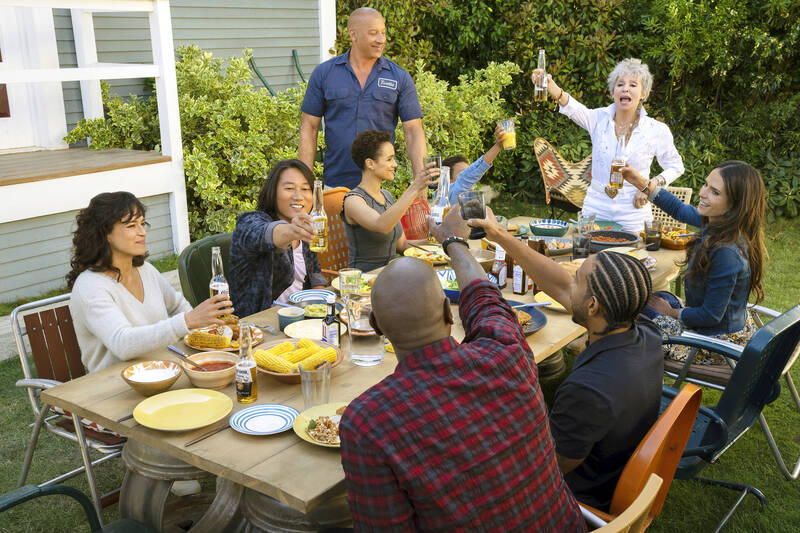Fans and critics may disagree over when exactly the Fast & Furious franchise jumped the shark, but there is only one correct answer: When the Pontiac Fiero went into space.
Weightless and violating every physical law, the floating car — tasked with bumping a satellite in the ninth installment — was the very symbol of how bloated and crazed the once-plucky series had become. There really was no way down after that.
And yet we have come to 10, part of a planned series of films finally saying goodbye. Fast X is, thankfully, shackled to Earth’s gravity — sometimes tenuously, it must be said — but it has become almost camp, as if it breathed in too much of its own fumes.

Photo: AP
Fast X reaches into the fifth movie — 2011’s Fast Five — for the seeds to tell a new story. In a memorable moment five movies ago, Vin Diesel’s Dom Toretto wrecked a bad guy and his team on a bridge in Rio de Janeiro. Little did we know then, but that bad guy had a son who survived and now, years later, vows vengeance. That’s it. That’s the plot.
That said, Fast X is monstrously silly and stupidly entertaining — just Wile E Coyote stuff, ridiculous stunts employing insane G-forces and everything seemingly on fire. There are elements of Mission: Impossible, 007 and John Wick, as if all the action franchises were somehow merging. But here’s a warning: It careens to an end without a payoff, a more dangerous stunt than any in the movies themselves.
The film would not be near enough as fun without Jason Momoa, who plays the bad guy’s son as a full-on flamboyant psycho, licking a knife clean after killing someone with it and painting the toenails of a dead victim as he displays the corpse in a demented garden party.

Photo: AP
“Never accept death when suffering is owed,” he says.
He is half Joaquin Phoenix from The Joker and half Jack Sparrow from Pirates of the Caribbean. Momoa has a penchant for planning explosions and then standing on a high spot and throwing his arms wide like Christ the Redeemer as the blast wave hits. The film sags as soon as he’s not in it.
Momoa is part of the franchise’s familiar tactic of stacking ever more stars with not enough to do — this time we also welcome Brie Larson, Alan Ritchson, Daniela Melchior and Rita Moreno. There’s even a Pete Davidson cameo.
That’s on top of regulars Michelle Rodriguez, Tyrese Gibson, Chris “Ludacris” Bridges, Jordana Brewster, John Cena, Jason Statham, Charlize Theron, Sung Kang, Scott Eastwood and Helen Mirren, whose attempt once again at a working-class accent is comical. This is a clown car of talent. The poster for the film includes 14 characters, like an Avengers movie.
At the center is the always-sleeveless Diesel, who keeps getting exposed as a truly terrible actor, one who evidently only attended the Brooding 101 seminar in drama school. The filmmakers usually just prop him up in front of a wall of family photos and he stares at them intently. “I only care about protecting the people that I love,” he will growl.
Family — as fans of the franchise know well — is always central, or rather, a gothic zero-sum notion of blood’s bond explained with soap opera dialogue. Toretto must protect family no matter the cost (but apparently OK with leaving his 8-year-old son in someone else’s care as he drag races in Rio).
“You know what your problem is?” teases Momoa. “Family. You can’t save them all.”
New director Louis Leterrier — from a screenplay by veteran Justin Lin and newcomers Zach Dean and Dan Mazeau — take us from Los Angeles to Antarctica, threatening much of Rome with a 20 kiloton bomb along the way and ending the movie at the side of a dam in Portugal in a cliffhanger. Stick around for the credits and even more mega-stars are promised for the next installment.
What you get this time are two brutal hand-to-hand fights, a car smashing two helicopters and rush hour traffic, car bombs, remote-controlled cars (big and small), vehicles that leap into the sky like salmon and a plane that drops a souped-up racer from its belly onto the highway.
Taking material from Fast Five means the delicate task of returning to Paul Walker, the franchise veteran who died in 2013. Old footage of Walker does appear in Fast X as the movie recreates events on that Rio bridge. It is handled respectfully and coolly. In a nice touch, Walker’s daughter, Meadow, has a cameo as a flight attendant.
With a foot in the past, one in the future and one on the gas, Fast X is pure popcorn lunacy. Was that too many feet? Oh, excuse us, you wanted logic?

In Taiwan there are two economies: the shiny high tech export economy epitomized by Taiwan Semiconductor Manufacturing Co (TSMC, 台積電) and its outsized effect on global supply chains, and the domestic economy, driven by construction and powered by flows of gravel, sand and government contracts. The latter supports the former: we can have an economy without TSMC, but we can’t have one without construction. The labor shortage has heavily impacted public construction in Taiwan. For example, the first phase of the MRT Wanda Line in Taipei, originally slated for next year, has been pushed back to 2027. The government

July 22 to July 28 The Love River’s (愛河) four-decade run as the host of Kaohsiung’s annual dragon boat races came to an abrupt end in 1971 — the once pristine waterway had become too polluted. The 1970 event was infamous for the putrid stench permeating the air, exacerbated by contestants splashing water and sludge onto the shore and even the onlookers. The relocation of the festivities officially marked the “death” of the river, whose condition had rapidly deteriorated during the previous decade. The myriad factories upstream were only partly to blame; as Kaohsiung’s population boomed in the 1960s, all household

Allegations of corruption against three heavyweight politicians from the three major parties are big in the news now. On Wednesday, prosecutors indicted Hsinchu County Commissioner Yang Wen-ke (楊文科) of the Chinese Nationalist Party (KMT), a judgment is expected this week in the case involving Hsinchu Mayor Ann Kao (高虹安) of the Taiwan People’s Party (TPP) and former deputy premier and Taoyuan Mayor Cheng Wen-tsan (鄭文燦) of the Democratic Progressive Party (DPP) is being held incommunicado in prison. Unlike the other two cases, Cheng’s case has generated considerable speculation, rumors, suspicions and conspiracy theories from both the pan-blue and pan-green camps.

Stepping inside Waley Art (水谷藝術) in Taipei’s historic Wanhua District (萬華區) one leaves the motorcycle growl and air-conditioner purr of the street and enters a very different sonic realm. Speakers hiss, machines whir and objects chime from all five floors of the shophouse-turned- contemporary art gallery (including the basement). “It’s a bit of a metaphor, the stacking of gallery floors is like the layering of sounds,” observes Australian conceptual artist Samuel Beilby, whose audio installation HZ & Machinic Paragenesis occupies the ground floor of the gallery space. He’s not wrong. Put ‘em in a Box (我們把它都裝在一個盒子裡), which runs until Aug. 18, invites